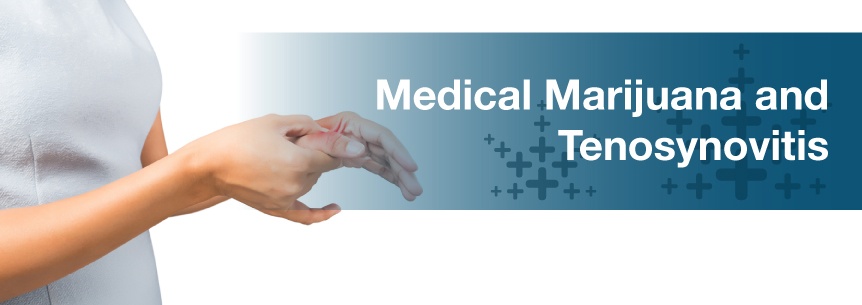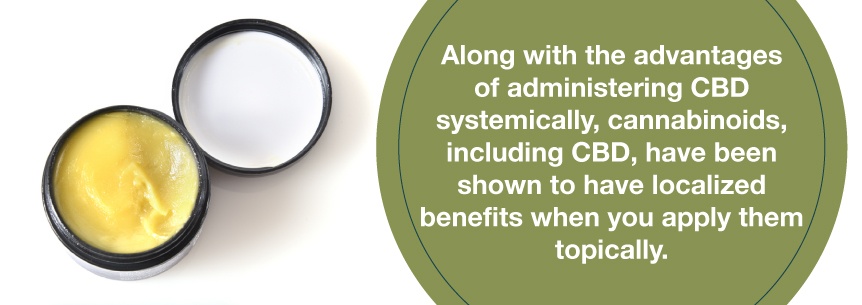
Inflammation isn’t always harmful to your health. Your immune system uses inflammation to help keep you protected from foreign substances like viruses, infection or bacteria. But, sometimes certain conditions, like tenosynovitis, can cause your immune system to respond inappropriately.
If there’s no foreign substance for it to fight off or the inflammation lasts too long, and these things can cause harmful side effects and damage healthy tissue. Medical marijuana not only helps treat inflammation, but also pain and other symptoms of tenosynovitis.
Tenosynovitis is synovial connective tissue inflammation. The synovium is a protective sheath covering your tendons. This keeps your tendon lubricated by producing synovial fluid. A tendon injury can result if the sheath malfunctions. When this occurs, your sheath could end up not making enough synovial fluid or none at all, causing swelling or inflammation of the sheath. Tenosynovitis usually affects your wrists, hands, and feet since your tendons are long across those joints. However, it can affect any tendon sheath.
Tenosynovitis is not the same thing as tendonitis, which means there’s inflammation of the tendon itself. But tendonitis and tenosynovitis often occur simultaneously.
Your tendons are a form of fibrous tissue connecting your muscles to your bones. If you didn’t have tendons, you wouldn’t have any control over your body’s movement. They help control actions such as jumping, running, lifting and grasping.
Common tenosynovitis symptoms often include:
Those suffering can experience a stiffening or weakness of the are lasting for more than a day or so. It can last for several weeks to months if serious and left untreated.
Some individuals might develop a fever, which is an indication of infection where they need immediate medical attention.
Sufferers of tenosynovitis often experience dysfunction and pain in the wrist, arms or hand, but it can also occur wherever they have a tendon in their body — typically a tendon that’s subject to repetitive motions. Individuals who are middle-aged have a greater risk of tenosynovitis, and their symptoms can come and go with rest or over time.
The cause of tenosynovitis inflammation isn’t always clear, but some common reasons for the condition include overuse, strain, infection or injury.
Injury can occur due to:
An underlying health condition can also cause tendon sheath inflammation. Some of these conditions include:
Doctors can’t determine the cause of the condition in some individuals. In rare cases, it can be the result of an infection resulting from a puncture or cut to the tendon.
Tenosynovitis isn’t limited to just athletes either. It appears in individuals who perform various repetitive-motion activities like weeding, typing or assembly-line work. Some people have a higher risk than others because of their jobs. Professions at higher risk include dentists, office workers, carpenters and musicians.

An infected cut to your wrists or hands that results in tenosynovitis might require surgery.
While tenosynovitis can affect any tendon in your body, there are certain areas in your body it seems to affect more. Because of this, they have their names and symptoms. For instance, two common forms of tenosynovitis are trigger finger and de Quervain’s tenosynovitis.
This type of tenosynovitis is also known as “trigger finger.” It affects your fingers, typically your thumb, third and fourth finger. It can affect multiple fingers or just one finger. The cause of trigger finger is localized swelling of your flexor hand tendons.
As these tendons start swelling, they begin to thicken too much for the sheath that covers them, catching on the sheath when you try to move your thumb or a finger. When this occurs, it causes your fingers to lock, leading to the “trigger finger” term since the finger pops back into its original position when it unlocks, similar to how individuals use it when releasing a firearm’s trigger.
De Quervain’s involves inflammation of your tendons at the side of your hand at the thumb’s base. It also involves swelling of your thumb’s tendon sheath. A repetitive strain of the muscle in the forearm facilitating thumb movement or the skeletal muscle on the back side of the forearm causes this common injury. Alternatively, daily activities like placing your child in a car seat or carrying heavy plastic-bagged groceries can cause this form of tenosynovitis.
If you have de Quervain’s, you might feel a sensation of “sticking” when you move your thumb. You may also have difficulty moving your wrist when trying to grasp an object. You will often experience pain in your wrist at your thumb’s base or pain when you move your thumb.
When you don’t treat de Quervain’s tenosynovitis, it can make it difficult for you to use your wrist and hand properly, limiting the range of motion of your wrist.
If you don’t treat infectious tenosynovitis quickly enough, it can lead to tissue death. If enough tissue dies, you might need to have the impacted body part amputated. An untreated infection can also spread to your bloodstream or nearby tissues.
Promptly treating tenosynovitis won’t eliminate the risk of complications. Studies have shown a 10 to 25 percent incidence rate of residual stiffness caused by:
Further complications might include:
Chronic pain can often cause depression and needs treatment to improve quality of life. Anxiety affects behaviors and thoughts negatively, hindering rehabilitation.
Chronic pain can also disturb your sleep, causing you to wake up at night and making you tired and unproductive during the day. The constant pain can lead to other irritations, making it hard for you to deal with other people. If you work full time or care for children, this all can make your life seem overwhelming and too challenging. Feelings like these can cause irritability, depression and even suicide.

Statistics about tenosynovitis according to the National Institutes of Health (NIH) include:
In 1895, Fritz de Quervain, a Swiss surgeon, published five case reports of individuals with thickened, tender first dorsal compartment at their wrist. Subsequently, the condition bears his name.
While we don’t know what exactly causes de Quervain’s, increased vascularity and myxoid degeneration with fibrous tissue deposits instead of acute synovial lining inflammation links to it.
Treatment for tenosynovitis focuses on reducing pain and inflammation. Your doctor will likely have you stop the activities that led to your initial injury and rest the affected area. They might recommend a splint or brace to immobilize the impacted area.
Applying cold or heat could also help reduce the pain and swelling. Other therapies your doctor might suggest are:
The doctor might also prescribe you medicine. Over-the-counter nonsteroidal anti-inflammatory drugs (NSAIDs) like ibuprofen or injectable corticosteroids might help. NSAID side effects may include:
Oral corticosteroids may cause side effects when used long-term — more than three months — including:
Tendon sheath injection with a steroid is typically successful in cases where there’s no infection, but sometimes surgery is needed to release the tendon sheath at the tendon. If an infection caused your condition, the doctor might prescribe you antibiotics to eliminate the infection.
Antibiotics can cause:
If an underlying health problem caused your condition, like gout or rheumatoid arthritis, your doctor might prescribe you medications for these issues. Talk to your doctor about the side effects of any medication prescribed.
Your doctor may suggest physical therapy or exercises once your tendon heals to strengthen the muscle. Muscle strengthening will help protect your tendon from future injury. If you have recurring inflammation of your tendon sheath, the doctor might suggest surgery to correct the issue.
Clinical trials relating to tenosynovitis are being or have been conducted for:
The Hebrew University of Jerusalem is producing pre-clinical trials of medical marijuana’s effects on inflammation. Their research appears to be exceeding research done in the United States on the same topic by leaps and bounds.

It is important research, as it is demonstrating the anti-inflammatory effects of marijuana and how it increases intestinal motility in individuals with digestive disorders. How this relates to tenosynovitis is that tenosynovitis is characterized by inflammation. Inflammation causes much of the pain, swelling and decreased mobility of the injured joints.
One of the most interesting aspects of the research conducted in various departments of the Hebrew University of Jerusalem on medical marijuana is that many of the derivatives used are not psychoactive. This means that the mind-altering effect so feared by many and what makes blind trials so difficult is a non-issue with these drugs.
Medical marijuana with no psychoactive effects can be and is used as an alternative to that which is psychoactive. However, there are several components to medical marijuana. A doctor may determine that the best components for an individual patient’s tenosynovitis are those that produce a “high.”
Tenosynovitis causes pain, and medical marijuana can relieve pain. The research in that area is overwhelming. Unlike other uses for marijuana, the studies for marijuana use for pain have been extensive. That is because medical marijuana is a treatment for cancer and AIDS, both very painful conditions in most cases.
This is the only area of medicine medical marijuana is allowed by the federal government of the U.S. Very few types of medical marijuana are approved for this treatment, though it is undeniable that the components of these medications are found in the marijuana plant and can be used to treat many kinds of pain.
Research on medical marijuana and pain was sufficient for FDA approval of a synthetic THC known as Marinol. Research is ongoing, but it is already clear that medical marijuana can reduce chronic pain and has several other benefits.
Researchers have noted that medical marijuana has a helpful quality. There is no known limit to how much marijuana an individual can ingest without long-lasting or fatal effects. That is in stark contrast to other pain relievers used for tenosynovitis. Even over-the-counter pain relievers can be fatal if taken irresponsibly. Pain relievers can also cause nausea. Medical marijuana does the opposite.
Some research has shown limits in the treatment of pain with marijuana. The most important of these limits is that it does not work for everyone. Nonetheless, that is the case with all pain relievers. For not always known reasons, medications can be inconsistent among sufferers. There is also a problem with dosage. In some studies, those individuals who had higher doses felt an increase in pain. It is essential to find the right dosage and stick to it. Once a tolerance builds up, higher doses may work better and will still have less alarming side effects than opiates.
Tetrahydrocannibinol is a main component of cannabis. When you ingest it into your body, it metabolizes into a metabolite helping both reductions of inflammation and pain relief. A synthetic form was found in animal testing to be effective against both chronic and acute inflammation. Additionally, it prevented destruction and protected the joint tissue.
People often believe traditional medication is best. However, this doesn’t seem to apply for medical weed since it’s much better than traditional medication because of its greater effectiveness and lower risk.
Medical marijuana treatment can help with tenosynovitis symptoms including:
Because of cannabis’s ability to control inflammation and reduce pain, it’s become a hugely promising remedy for tenosynovitis. When using marijuana for tenosynovitis sensibly, you can manage the condition-related pain more easily.
Medical marijuana is extremely helpful in managing pain. Cannabis’s cannabinoids act on the CB1 and CB2 receptors involved in the mediation of the inflammation-related pain.
Even so, studies found medical pot effective in improving sleep too. Anecdotal evidence from those who use the herb often shows great results when the herb is used for sleep.
Research on anxiety and medical cannabis shows the herb has similar elements to anxiety medications. Studies found marijuana’s components, particularly CBD, also help manage chronic inflammation.
Research by the University of Southern California on depression and marijuana showed that among the 4,400 individuals surveyed, the individuals who used cannabis displayed fewer signs of depression than the individuals who didn’t use the herb.
You should look for marijuana strains for tenosynovitis that come from the indica plant. The plant has high CBD to THC ratio, minimizing your risk of anxiety or of getting “high” while reducing pain and inflammation significantly.
Along with the advantages of administering CBD systemically, cannabinoids, including CBD, have been shown to have localized benefits when you apply them topically. For instance, cannabinoids applied topically have been shown to relieve pain and other ailments that originate near the skin surface.

Also, cannabinoids applied topically help relieve pain and other ailments linked with deeper tissues, such as peripheral neuropathic pain. You might still want to co-administer cannabinoids systemically.
Other methods include:
For more information on marijuana and tendon sheath inflammation, find a cannabis doctor here at MarijuanaDoctors.com. We have tons of resources to help you along your cannabis journey, including a huge database of dispensaries to choose from. Begin benefiting from this powerful and safe treatment today.
Find A Doctor Find A Dispensary